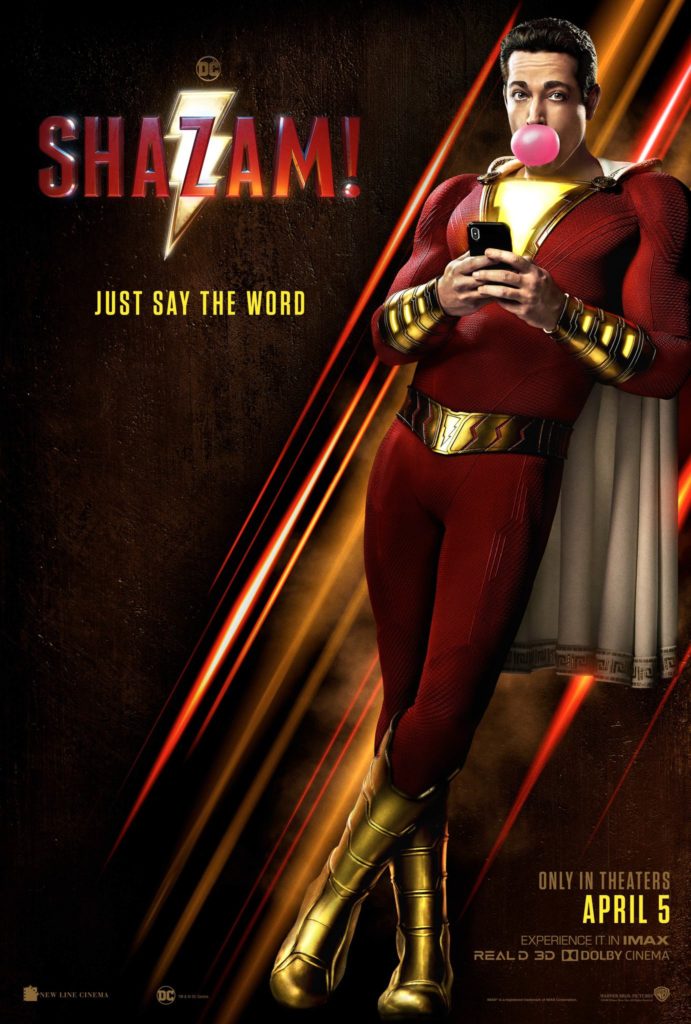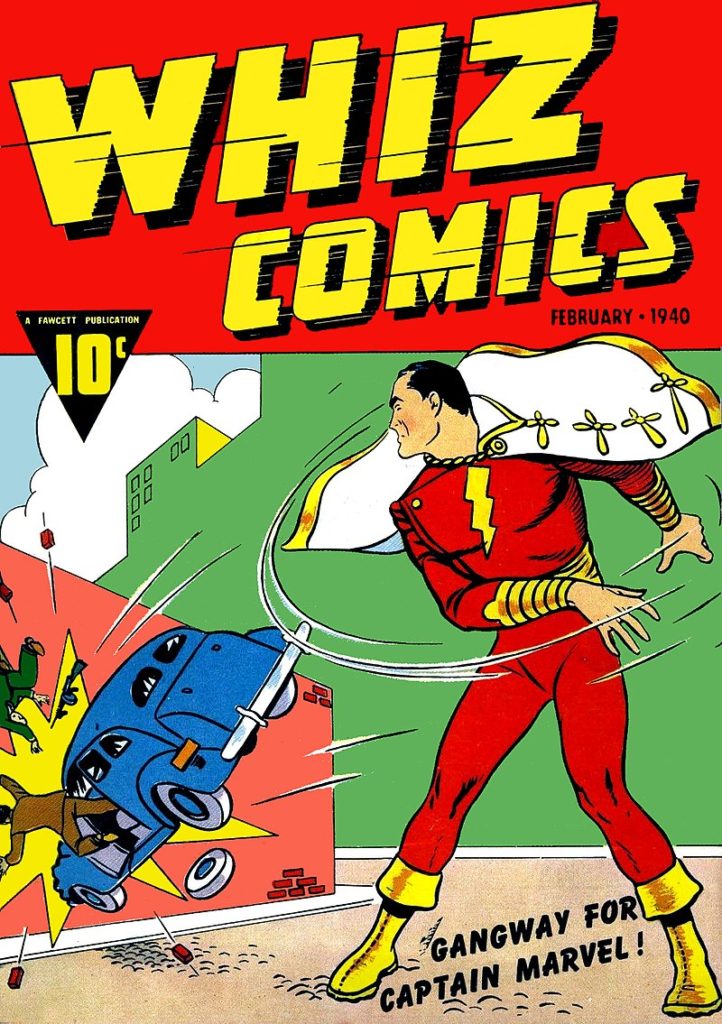
@TheBelser
What’s happening, my people. The Belser is here and ready to kick off a very special series of articles here on GodHatesGeeks. The purpose of this piece? Two words: Captain Marvel. Before the end of May, three Hollywood blockbusters are going to be released to theaters around the world presenting two characters that have shared that one name: Captain Marvel, Shazam! and Avengers: Endgame. As a result, there’s going to be ton of questions that the general public are just not up on. Why are there so many of them? Why is there one for Marvel and one for DC? How come only Marvel gets to use the name Captain Marvel? Why is the DC one called Shazam?
You see that? That’s where I come in. The character Captain Marvel has one of the most complex histories of any comic character ever created. It’s a character that I find infinitely fascinating which is why I volunteered to embark on this little journey. This is meant to be a guide for those who would like to know more about the fascinating character and its history. So, without further ado, let’s get started. Shall we? For the purpose of this discussion, we are going to start with the very first Captain Marvel. The one that is currently known to DC Comic fans as Shazam!
How I Found the Character
My first knowledge of this character came in the form of a short-lived crossover comic I got at a K-Mart called DC versus Marvel in 1996. The general gist of it was that a cosmic battle between two entities from two different universes was waged in war and decide to pit the heroes of their respective universes against one another to decide which universe was stronger: Marvel or DC. As a result, a lot of the fans got several dream matchups that they have been waiting for years to see. Superman vs The Hulk, Batman vs Captain America and the Flash vs Quicksilver were just a few of the matchups on hand. Captain Marvel was put into the mix as well and his opponent was the Mighty Thor because of their similar mythological roots. My first thought of the character was “Yo! this dude looks like Superman. But Superman is already fighting somebody. Who is this cat?”. Plus, back in the day, I used to draw a lot and I really loved drawing Captain Marvel. Being the bookworm that I am, I just want to know more and more about the character. Little do I know the size of the ball of thread that I was pulling on.
Inspiration
To start this off, the character you know now is currently owned and printed by DC Comic. However, he was not created by DC Comics initially. In fact, the character was created by another independent company known as Fawcett Publications. Founded in 1919 by Wilford Hamilton Fawcett, best known as “Captain Billy”. The main source of the company’s momentum was a magazine called Captain Billy’s Whiz Bang. With its lewd but funny poetry and jokes, Captain Billy’s was considered the most prominent comic magazine in America of the 1920s.
Then, along came Superman, who debuted in Action Comics # 1 in June 1938. After seeing the immediate success of that character, Fawcett and many other publishers said to their staff, ‘I want that. Give me that!’. For this, Fawcett recruited writer Bill Parker and artist C.C. Beck to create a new feature comic and a main character for it. According to an article in the blog, The Hembeck Files, the first choice for this new lead feature would be a group of six heroes, each with a different power based on Greco-Roman mythology. However, Fawcett Executive Director Ralph Daigh felt that a single hero would be better than a group of heroes and merged them into a single character (Hembeck, 2003). Another additional suggestion came from Fawcett’s circulation director Roscoe Kent Fawcett who stated, “Give me a Superman, only have his other identity be a 10- or 12-year-old boy rather than a man” (Hamerlinck, 2001). The new feature was named Whiz Comics (after Captain Billy’s Whiz Bang) and the main character’s secret identity was named Billy Batson (after publisher ‘Captain Billy’ Fawcett). The character’s super hero name was first Captain Thunder. That was soon changed to Captain Marvelous before everyone settled on one name: Captain Marvel.
Origin
Debuting in Whiz Comics # 2 (published in 1939 but released in February 1940), the readers were introduced to a young 12-year-old orphan named Billy Batson. Billy is homeless and scrapping by a living, selling newspapers. One rainy night, Billy is led to a closed subway station by a darkly dressed stranger. I’m guessing there was no such thing as ‘stranger danger’ in the 1940s. Anyways, both Billy and the stranger board a subway train covered in weird hieroglyphics. This train itself leads to a large hall lined with large statues. Each statue represents ‘The Seven Enemies of Man’ which are better known to Christians as the seven deadly sins. With the stranger disappearing, Billy enters a large cave with a single stone throne. Seated in said throne is an extremely old man with a long white beard and a flowing white robe. This would be the ancient wizard known as Shazam.
NOTE: It’s very clear Shazam was meant to be an analog of the legendary wizard Merlin from the tales of King Arthur (a boy who was also chosen to become a great hero). Shazam explains to Billy that he knows the child’s entire life story and that the wizard has been protecting the Earth for over 3,000 years. However, his time is at an end and he had chosen Billy as his successor, due to Billy’s pure heart. He promises to make Billy into his champion or –more specifically– The World’s Mightiest Mortal. All Billy must do the Wizard’s name out loud. After saying the word Shazam, Billy changed immediately from a 12-year boy into a large muscular adult man complete with new powers and a bright red suit. The Wizard instructs Billy to use his new form to safeguard the world from all things evil. With that, the Wizard’s physical form is destroyed by a large boulder. However, the Wizard’s spirit returns long enough to let Billy know he can be summoned at any time for guidance by lighting a special brazier.
Essentially, he became the Obi-Wan Kenobi to Billy’s Luke Skywalker. After learning he can change from Captain Marvel to Billy by saying the Wizard’s name again, the character’s adventures begin. He even scores a job as a radio reporter for WHIZ Radio at age 12. He goes from being homeless to globe trotting around the world and having his own secretary. At AGE 12!! Only in comics, man. Aside from a few changes here and there in different media, this is the general origin presented for Shazam/Captain Marvel.
Appearance
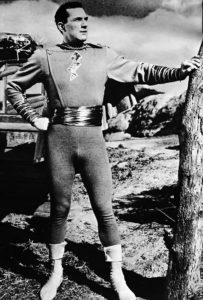 The appearance of the superhero is based on then-popular actor Fred MacMurray. I grant you that most modern audiences are not going to know who Fred MacMurray is. He was an acclimated actor known for lead roles in films like Double Indemnity and shows like My Three Sons. If you are an old school Disney aficionado like me, you will know he played the original version of The Absent-Minded Professor (which was remade into the 1997 Robin Williams movie Flubber). That’s how I know him. As for his costume, both Captain Marvel and Superman owe a debt to 1930’s circus performers like acrobats, magicians and strongmen. Captain Marvel’s costume bears a lot of similarities to another DC hero, The Flash. Both have all red form fitting costumes with gold belts, gold boots and a large lightning insignia on the chest. One unique feature is that Captain Marvel’s torso top resembles a tunic with buttons in some versions. Also, his cape is usually a lot shorter than most caped heroes. It can be considered a half-cape and certain versions have it embroidered with golden Egyptian ankhs to denote the Wizard’s origins. The most recent versions have the cape longer and have added a hoodie.
The appearance of the superhero is based on then-popular actor Fred MacMurray. I grant you that most modern audiences are not going to know who Fred MacMurray is. He was an acclimated actor known for lead roles in films like Double Indemnity and shows like My Three Sons. If you are an old school Disney aficionado like me, you will know he played the original version of The Absent-Minded Professor (which was remade into the 1997 Robin Williams movie Flubber). That’s how I know him. As for his costume, both Captain Marvel and Superman owe a debt to 1930’s circus performers like acrobats, magicians and strongmen. Captain Marvel’s costume bears a lot of similarities to another DC hero, The Flash. Both have all red form fitting costumes with gold belts, gold boots and a large lightning insignia on the chest. One unique feature is that Captain Marvel’s torso top resembles a tunic with buttons in some versions. Also, his cape is usually a lot shorter than most caped heroes. It can be considered a half-cape and certain versions have it embroidered with golden Egyptian ankhs to denote the Wizard’s origins. The most recent versions have the cape longer and have added a hoodie.
Powers:
While Captain Marvel/Shazam is often compared to Superman for their similar powers, Superman’s powers are a result of his alien nature and have scientific roots. Captain Marvel is a product of magical energies. The letters in the name SHAZAM each denote a superhuman ability from a specific mythological figure. Captain Marvel is a living avatar of that combined power.
Here is how each letter is represented in terms of Captain Marvel’s powers:
S for the Wisdom of Solomon
Solomon was a king of Israel known for his great knowledge and wisdom.
This gives Captain Marvel/Shazam instantaneous access to a ridiculous amount of scholarly knowledge. It also gives him an exceptional ability to look at situations tactically and react as needed. That can be seen to some as wisdom. He also knows all of Earth’s languages and sciences. According to Blog Adventures, “he has exceptional photographic recall and mental acuity allowing him to read and decipher hieroglyphics, recall everything he has ever learned and solve long mathematical equations” (Cimino, 2011).
H for the Strength of Hercules
Hercules was a Greco-Roman hero and demigod (a God/human hybrid) most known for his legendary strength.
This makes Captain Marvel/Shazam one of DC Comics’ strongest heroes ever. He can perform feats of strength like bending steel with his bare hands and lifting massive objects like trucks and battleships. He is one of the few characters that can legit go toe to toe in a fight with Superman and has, on occasion, beaten the Man of Steel. In fact, like Superman, he was strong enough to literally move planets doing the World War II years.
A for the Stamina of Atlas
Atlas was a Greek Titan best identified in various stories and art work by the image of him holding up the entire planet Earth for all eternity.
The prevents him from getting tired and lets him physically exert himself for an undetermined amount of time. It also provides him with a supernatural healing factor. “He does not need to eat, breathe or sleep and can survive unaided in space” (Cimino, 2011).
Z for the Power of Zeus
Zeus is the king and all-father of the Greeks Gods. He is always known as the God of Lightning and Thunder.
This power creates the magic thunderbolt that transforms Billy Batson into Captain Marvel/Shazam. It also gives him resistance against all magic spells. In the past, Captain Marvel/Shazam has the lightning bolt as a weapon by saying the word Shazam, dodging it and allowing it to strike an opponent. It also allows him to give a piece of his power to others like Captain Marvel Jr and Mary Marvel. The magic lightning can also be used to heal extensive damage done to the hero, much like how yellow sun can heal Superman. In recent years, this power allows him to able to generate and control lightning or electricity from his own body. He also can use it to project lightning blasts from his fingertips, like the Spider-Man villain Electro or Storm from the X-Men.
A for the Courage of Achilles
Achilles was a great Greek hero of The Trojan War. The legend has that he made to be invincible by his mother who dipped his body in the River Styx (which takes you to the Underworld) as an infant. The problem was that she held him by one of his heels which would become his ultimate weakness. Hence the use of the term ‘Achilles’ Heel’ as a sign of weakness in an otherwise strong person.
This power is the source of Captain Marvel/Shazam’s invulnerability. He can stop bullets, bombs, laser weapons and other forms of attacks with no harm to himself. This also makes immune to all Earthly diseases, most magic spells and mental attacks. The power affects him psychologically as well. The courage of Achilles gives Captain Marvel/Shazam a natural confidence and optimism that can come across as courage and bravery. It also gives him innate fighting skills like the Greek warrior Achilles himself.
M for the Speed of Mercury
Mercury is the God of Travelers known for his flight through the heavens and quick speed. He is also known as a trickster god, the God of Sports, the messenger of the Gods and the guide to the Underworld.
This power gives Captain Marvel/Shazam to ability to levitate, hover or, otherwise fly. This power also gave him an initial one-up on Superman. That’s right. Of the two, Captain Marvel had the power to fly BEFORE Superman. According to an online article Reclaiming History: Superman Vs. Captain Marvel, Captain Marvel/Shazam has been flying since his fifth appearance in WHIZ COMICS #5, (June 1940). On the other hand, Superman’s first flight was not until the timeframe of May/June 1941 in the Fleischer Studios’ Superman cartoons and his nationally syndicated radio show The Adventures of Superman (Tano, 2011). While not as fast as The Flash, Captain Marvel/Shazam can travel at speeds exceeding Mach 10 or 2 miles per second.
Supporting Cast:
It wasn’t before a long that Captain Marvel became Fawcett’s flagship character. As a result, he was given a wider supporting cast to bring in even more readers from different demographics. Here’s a breakdown of The Marvel Family:
Captain Marvel Jr.
The first of this new ‘family’ would be Freddie Freeman, a crippled friend of Billy’s. After an accident leaves him near death, The Wizard Shazam allows Billy to give a portion of his power to Freddy so he can live. As a result, Freddy could become a teenage version of Captain Marvel by saying the name ‘Captain Marvel’, like how Billy shouts Shazam. Thus, Freddy becomes Captain Marvel Jr. Captain Marvel Jr. had all the same powers but with a few differences. For instances, when he transformed, he remained a child (albeit a healthy one with two working legs) and his costume was all blue with a red cape. NOTE: one special fan of Captain Marvel JR. was none other the King of Rock and Roll, Elvis Presley. Elvis collected Captain Marvel Jr. comics and his trademark hairstyle is based on the character. Another big indicator of Elvis’ fandom are the flashy stage outfits of his later career (with a half-cape like Captain Marvel) and his TCB (Taking Care of Business) logo with a Captain Marvel-like lightning bolt on it (Reed, 2018).
Mary Marvel:
The next addition orphan Billy Batson gains is a lost twin sister named Mary Bromfield. As it turns out, they were separated at birth and she went on to live with a nice family while Billy did not. They discover each other during a chance encounter at Billy’s radio and they both have one half of a locket of their parents. Of course, Mary wants to get into the superhero game as well. By saying the word Shazam, Mary could turn into a female version of Captain Marvel called Mary Marvel. Her version of SHAZAM is an acronym as well with the exception that the deities Mary get her powers from are all female. NOTE: The design and personality of Mary Marvel is based on classic actress Judy Garland (Hamerlinck, 2001).
The Silly Marvels:
For a more comedic edge, they gave Billy an Uncle Dudley, an old con artist who acted as the ‘manager’ of the Marvel Family. In fact, Uncle Dudley would say the word Shazam too, but nothing would happen. Instead, he will quickly change his clothes into a Captain Marvel costume facsimile and was dubbed Uncle Marvel. Then, there came the Lieutenant Marvels. The Lieutenants are presented as three young Captain Marvel fanboys from different parts of the country (one was tall, one was fat and one was a hillbilly) who all happened to be named Billy Batson. When they say Shazam, they basically became adult versions of themselves with less power than the actual Captain Marvel and became his backup team of sorts. Oh, it gets even stranger than that. He also befriended a character named Tawky Tawny who was a talking Tiger who walked like a man, wore plaid sportscoats and made wisecracks. I’m not kidding at all. In recent years, they have given Tawky Tawny a reboot as just a friendly tiger at the zoo that Billy frequents. Keep in mind, these characters are all inventions of the Golden Age of Comics and comics were not taken as seriously as they are now.
Enemies
As far as Captain Marvel’s Rogues Gallery close it kind of borders on the more humorous side than most other Heroes. However, there are a few exceptions in the bunch that make the grade as archenemy status.
Doctor Sivana:
 While Superman had Lex Luthor, Captain Marvel had Doctor Sivana. Doctor Sivana is the character’s longest running recurring arch-villain. In fact, he is the character’s very first supervillain as he debuted in the very same comic as Captain Marvel. Doctor Sivana follows the classic stereotype of the mad scientist bent on world domination. Fun fact: Dr. Sivana debuted two months BEFORE Lex Luthor (Sivana debuted in February 1940, Luthor came out in April). Sivana would always threaten to cause damage with some invention of his if his demands are not met. His motivations include simple extortion, world domination or the destruction of Captain Marvel and The Marvel Family. Appearance-wise, Sivana is a bald, scrawny little man with repulsive features like pointed ears and protruding teeth. Note: the character’s look is based on German actor Max Shreck, who played the vampire Count Orlok in the classic silent film Nosferatu. He was the first major comic villain to regularly use the term ‘Curses! Foiled Again!’ and often refers to Captain Marvel by the not-so-flattering nickname The Big Red Cheese. In recent years, Sivana has been reinvented into a corrupt business tycoon (a la Lex Luthor) and an archeologist that can ‘see’ magic after an accident. In the upcoming movie, he will be played by actor Marc Strong, who also played Sinestro in the Green Lantern film.
While Superman had Lex Luthor, Captain Marvel had Doctor Sivana. Doctor Sivana is the character’s longest running recurring arch-villain. In fact, he is the character’s very first supervillain as he debuted in the very same comic as Captain Marvel. Doctor Sivana follows the classic stereotype of the mad scientist bent on world domination. Fun fact: Dr. Sivana debuted two months BEFORE Lex Luthor (Sivana debuted in February 1940, Luthor came out in April). Sivana would always threaten to cause damage with some invention of his if his demands are not met. His motivations include simple extortion, world domination or the destruction of Captain Marvel and The Marvel Family. Appearance-wise, Sivana is a bald, scrawny little man with repulsive features like pointed ears and protruding teeth. Note: the character’s look is based on German actor Max Shreck, who played the vampire Count Orlok in the classic silent film Nosferatu. He was the first major comic villain to regularly use the term ‘Curses! Foiled Again!’ and often refers to Captain Marvel by the not-so-flattering nickname The Big Red Cheese. In recent years, Sivana has been reinvented into a corrupt business tycoon (a la Lex Luthor) and an archeologist that can ‘see’ magic after an accident. In the upcoming movie, he will be played by actor Marc Strong, who also played Sinestro in the Green Lantern film.
Captain Nazi:
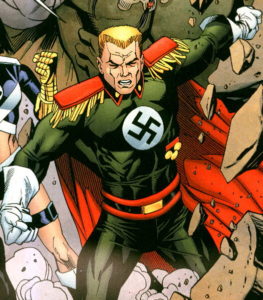 During World War II, comics were used as propaganda tools to get readers to support the Allied war effort against Nazi Germany. As such, they would create comic book scenarios with superheroes supporting the troops in different ways. They would even create evil characters meant to represent the Nazi threat like Marvel’s The Red Skull. Fawcett came up with their own in the form of Captain Nazi. The story of Captain Nazi is very similar to that of Captain America: a young man is transformed by science into the perfect human or the Ubermensch(German for Superman) to serve his country. Captain Nazi and Captain Marvel fought frequently during the war years and still engages in battle with the character to this day. Captain Nazi was portrayed in live action for the first time by actor André Eriksen on an episode of DC’s Legends Of Tomorrow.
During World War II, comics were used as propaganda tools to get readers to support the Allied war effort against Nazi Germany. As such, they would create comic book scenarios with superheroes supporting the troops in different ways. They would even create evil characters meant to represent the Nazi threat like Marvel’s The Red Skull. Fawcett came up with their own in the form of Captain Nazi. The story of Captain Nazi is very similar to that of Captain America: a young man is transformed by science into the perfect human or the Ubermensch(German for Superman) to serve his country. Captain Nazi and Captain Marvel fought frequently during the war years and still engages in battle with the character to this day. Captain Nazi was portrayed in live action for the first time by actor André Eriksen on an episode of DC’s Legends Of Tomorrow.
Black Adam:
 If you ask most modern audiences who are familiar with Captain Marvel/Shazam how his current archenemy is, this is the character they would name. Black Adam. The funny thing is that character was originally just supposed to be a one-time villain. The character was used once in 1945 and was not used again until the 1970s. During the time of the Pharaohs, Black Adam was an ancient Egyptian named Teth-Adam who was chosen to be the wizard Shazam’s first champion. However, Black Adam’s new-found power corrupted him, and he decided to use his power to rule all of Egypt and eventually, the entire world. Seeing his mistake, Black Adam was banished by Shazam to the farthest reaches of space to remain for all time. Unfortunately, Black Adam made his way back to Earth and continually confronts the wizard’s new champion Captain Marvel.
If you ask most modern audiences who are familiar with Captain Marvel/Shazam how his current archenemy is, this is the character they would name. Black Adam. The funny thing is that character was originally just supposed to be a one-time villain. The character was used once in 1945 and was not used again until the 1970s. During the time of the Pharaohs, Black Adam was an ancient Egyptian named Teth-Adam who was chosen to be the wizard Shazam’s first champion. However, Black Adam’s new-found power corrupted him, and he decided to use his power to rule all of Egypt and eventually, the entire world. Seeing his mistake, Black Adam was banished by Shazam to the farthest reaches of space to remain for all time. Unfortunately, Black Adam made his way back to Earth and continually confronts the wizard’s new champion Captain Marvel.
Appearance-wise, Black Adam is a large tanned man with pointed ears like Spock from Star Trek. Black Adam also fulfills another classic trope in comics where the hero fights an evil version of himself. Black Adam has all the same powers as Captain Marvel/Shazam. He usually shown as having a lot more experience with them than Billy and lacks that moral compass that Billy has. NOTE: like Mary Marvel, when Black Adam says Shazam!, his acronym is different from Billy’s as his Is made of Egyptian gods, not Greco-Roman. In recent years, the character of Black Adam has risen to a level of prominence in the comics community. Starting the Filmation animated series in the 80s, Black Adam has been the featured villain in almost of Captain Marvel/Shazam’s animated appearances. So much so, Black Adam is slated to receive his own live action movie and will be portrayed by Dwayne ‘The Rock ‘Johnson.
MAJOR MULTIMEDIA APPEARANCES
The Adventures of Captain Marvel:
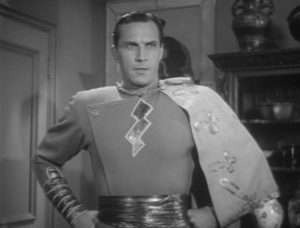 Given the character’s success, it was only a matter of time before Hollywood would come a-calling. In this case, it would be the now-defunct Republic Pictures, who proposed a 12-chapter black and white serial starring Captain Marvel. For you youngsters out there, serials were the Depression ear equivalent of Saturday morning cartoons. They were shown in weekly chapters at local movie theaters and they also ended with an exciting cliffhanger that prompted viewers to come back the next week to see what happens. The structure of serials is what inspired filmmakers like Steven Spielberg and George Lucas to create modern film blockbusters such as Star Wars and Indiana Jones. Produced in 1941, The Adventures of Captain Marvel is significant in motion picture history as it is the first-ever live action depiction of a superhero on film. It starred movie cowboy Tom Tyler as Captain Marvel and Frank Coghlan, Jr. as Billy Batson. The serial’s storyline follows The Malcom archaeological expedition into Siam (which is modern day Thailand) to find the lost secrets of the Scorpion Kingdom. Hidden inside a sealed crypt, they discover the Golden Scorpion, a device whose quartz lenses can be aligned and create powerful energy beams. After a warning not to enter the crypt is ignored, expedition member Billy Batson is then chosen by the ancient wizard Shazam. The wizard grants Billy the powers of Captain Marvel which can be used only to protect those in danger from the curse of the Golden Scorpion.
Given the character’s success, it was only a matter of time before Hollywood would come a-calling. In this case, it would be the now-defunct Republic Pictures, who proposed a 12-chapter black and white serial starring Captain Marvel. For you youngsters out there, serials were the Depression ear equivalent of Saturday morning cartoons. They were shown in weekly chapters at local movie theaters and they also ended with an exciting cliffhanger that prompted viewers to come back the next week to see what happens. The structure of serials is what inspired filmmakers like Steven Spielberg and George Lucas to create modern film blockbusters such as Star Wars and Indiana Jones. Produced in 1941, The Adventures of Captain Marvel is significant in motion picture history as it is the first-ever live action depiction of a superhero on film. It starred movie cowboy Tom Tyler as Captain Marvel and Frank Coghlan, Jr. as Billy Batson. The serial’s storyline follows The Malcom archaeological expedition into Siam (which is modern day Thailand) to find the lost secrets of the Scorpion Kingdom. Hidden inside a sealed crypt, they discover the Golden Scorpion, a device whose quartz lenses can be aligned and create powerful energy beams. After a warning not to enter the crypt is ignored, expedition member Billy Batson is then chosen by the ancient wizard Shazam. The wizard grants Billy the powers of Captain Marvel which can be used only to protect those in danger from the curse of the Golden Scorpion.
I recently watched this collection of serials on YouTube. In all honesty, it’s not that bad at all! Yes. it’s cheap by today’s standards and some of the dialogue is borderline racist but if you consider the time frame and how it came out looking is fantastic. The stunt work is very good. In fact, Billy Batson gets as much fight time as Captain Marvel. This version of Captain Marvel is also a lot more hardcore than you would normally see in the comics. He straight up kills several thugs throughout these episodes like the Keaton and Affleck Batman portrayals. He throws them off bridges, lets them to the death and at one point, he gets control of a machine gun and mows downs several Siam natives. Brutal!
One of the things that impressed me most about this serial was the flying effects. For the close-ups, they did the classic rear projection shots with the actor laying still with the screen going past them in the background. The real kicker are the wide flying shots. They used a large paper mache dummy of the character that basically just glided along two wires. It was over 7 ft tall and weighted 15 lbs., complete with a silk costume and a naturally flapping cape. The thing is the effect works best from a distance as you don’t really see the wires at all. Up close, it’s obvious. Still, this is a very fun thing to watch.
Filmation (live action and animated):
 DC Comics had acquired the rights to the Captain Marvel and all his related characters in 1972 after an extensive lawsuit (More on that in another article). DC attempted a revival of the character in the comics and on television. Filmation Studios are responsible for such cartoons as Fat Albert and the Cosby Kids, Star Trek the Animated Series (which reunited the original cast of Star Trek after it was cancelled) and their most popular creation, He-Man and the Masters of the Universe. A partnership between DC Comics and Filmation Studios had existed since 1960s. Filmation produced a number of cartoon shows in 1967 that featuring many of the DC superheroes, like Superman, Aquaman, The Flash, Hawkman and The Atom.
DC Comics had acquired the rights to the Captain Marvel and all his related characters in 1972 after an extensive lawsuit (More on that in another article). DC attempted a revival of the character in the comics and on television. Filmation Studios are responsible for such cartoons as Fat Albert and the Cosby Kids, Star Trek the Animated Series (which reunited the original cast of Star Trek after it was cancelled) and their most popular creation, He-Man and the Masters of the Universe. A partnership between DC Comics and Filmation Studios had existed since 1960s. Filmation produced a number of cartoon shows in 1967 that featuring many of the DC superheroes, like Superman, Aquaman, The Flash, Hawkman and The Atom.
The company produced a live-action version of the Captain Marvel character. However, the name Captain Marvel was now owned by DC Comics’ chief rival, Marvel Comics. Hence, the show and all promotion pertaining to the character had be produced under the name Shazam! It was the studio’s first ever live action show. Shown on Saturday mornings on CBS from 1974 to 1976, the show starred actor Michael Gray as Billy Batson as he traveled across the country in a Winnebago with an elder mentor named Mentor (played by actor Les Tremayne). Occasionally, If Billy needed any real guidance, he could consult an animated counsel of the deities in which his powers are based. The show’s formula was simple: Billy and Mentor would encounter different young kids in their travels. The kids themselves would usually has some sort of problem and said problem would require intervention of Captain Marvel. Its live action special effects are super cheesy and very low budget. One innovation of the show is that each episode would end with Captain Marvel himself going over the lesson of the episode for the young viewers in a PSA.
This trend would be done to death in the eighties and nineties on shows like G.I. Joe, He-Man, Transformers and Captain Planet. The show also had two different actors play Captain Marvel, Jackson Bostwick and John Davey. In my opinion, the second of the two, John Davey, is the better portrayal as he came across more natural in the role. After the live action show was cancelled, Filmation came up with an animated version of Captain Marvel in 1981 once again titled The Kid Super Power Hour with Shazam! Made up of two segments, this version was closer to the old Golden Age comics. The other segment, Hero High, featured a high school full of kid superheroes and featured The Marvel Family in certain episodes. The cartoon itself was boring overall. However, its best episodes featured Black Adam as the enemy.
DC Animated Universe:
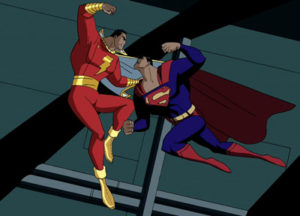 After both Filmation series ended, the character never became the lead of his own television series again. Instead, he would serve in a special guest star capacity on several popular DC Comics animated shows. These would include Justice League Unlimited, Young Justice, Batman: The Brave and the Bold and several their animated films. One coincidence to note is that most of these appearances have the character either collaborating with, or having a confrontation, against Superman. In these appearances, it is even more obvious, as well as exciting, to update the character to a new, modern audience, as well as contrasting him against a more modern version of the Man of Steel. Theirs contrasts always made for great drama.
After both Filmation series ended, the character never became the lead of his own television series again. Instead, he would serve in a special guest star capacity on several popular DC Comics animated shows. These would include Justice League Unlimited, Young Justice, Batman: The Brave and the Bold and several their animated films. One coincidence to note is that most of these appearances have the character either collaborating with, or having a confrontation, against Superman. In these appearances, it is even more obvious, as well as exciting, to update the character to a new, modern audience, as well as contrasting him against a more modern version of the Man of Steel. Theirs contrasts always made for great drama.
Superman:
I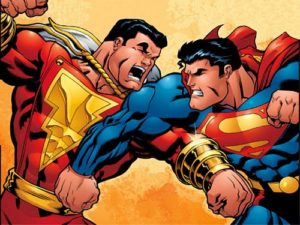 n case you haven’t noticed, the one character that has been name checked in this article as much as Captain Marvel himself is Superman. Superman is the original superhero and the character that introduced this entire genre to the world. Superman is the most clear and obvious influence on Captain Marvel. His very existence is due to an attempt to replicate the success of the Man of Steel. The character took a lot of conventions almost directly from Superman. Both characters are large muscle-bound dark-haired Boy Scouts with very similar powers and reporter alter egos. Both characters are often found fighting bald mad scientists, gangsters, monsters, aliens and villains that wear dark versions of themselves. They also had an extended family of similar clad individuals. While Superman has Superboy, Supergirl and Krypto the Super Dog, Captain Marvel has Captain Marvel Jr., Mary Marvel and Hoppy The Marvel Bunny. The big difference between the two characters is basically in terms of outlook. Superman was science-based while Captain Marvel was magic based. Another big difference is that fact Captain Marvel doesn’t have all the different types of vision powers that Superman has (heat vision, x-ray vision, etc.) Plus, Captain Marvel stories are often written in a lighter, more comical tone than Superman comics which appeals more to younger readers.
n case you haven’t noticed, the one character that has been name checked in this article as much as Captain Marvel himself is Superman. Superman is the original superhero and the character that introduced this entire genre to the world. Superman is the most clear and obvious influence on Captain Marvel. His very existence is due to an attempt to replicate the success of the Man of Steel. The character took a lot of conventions almost directly from Superman. Both characters are large muscle-bound dark-haired Boy Scouts with very similar powers and reporter alter egos. Both characters are often found fighting bald mad scientists, gangsters, monsters, aliens and villains that wear dark versions of themselves. They also had an extended family of similar clad individuals. While Superman has Superboy, Supergirl and Krypto the Super Dog, Captain Marvel has Captain Marvel Jr., Mary Marvel and Hoppy The Marvel Bunny. The big difference between the two characters is basically in terms of outlook. Superman was science-based while Captain Marvel was magic based. Another big difference is that fact Captain Marvel doesn’t have all the different types of vision powers that Superman has (heat vision, x-ray vision, etc.) Plus, Captain Marvel stories are often written in a lighter, more comical tone than Superman comics which appeals more to younger readers.
Ever since DC Comics acquired the Captain Marvel/Shazam character, the Superman/Captain Marvel combination or confrontation has become a regular staple in DC comics lore. Depending on who is writing the comics, Superman has been either a friend/mentor or rival/enemy to Captain Marvel/Shazam for most of the character’s existence. In fact, Superman has been the character’s greatest enemy outside the comics as well. That, however, is another story for another time.
Influence, Success and Appeal of Captain Marvel:
Truth be told, Captain Marvel was the most popular superhero of the 1940s. He outsold every other character (including Superman) by a large margin. Captain Marvel Adventures sold fourteen million copies in 1944 alone and was at one point being published bi-weekly with a circulation of 1.3 million copies an issue (Lavinie, 1998). Captain Marvel was a whole new level of wish-fulfillment for kids. I would say even more so than Robin the Boy Wonder, who debuted around the same time. Instead of being a kid that dressed up like the hero and got to have adventures with him/her, the kid could actually become the superhero. That, to me, is the key to the character’s initial success. The concept of a young person being able to say a magic word or a phrase and transforming into a superhero has been copied many times over. Examples include Hanna-Barbera’s Mighty Mightor, Filmation heroes He-Man and She-Ra and a British adult version called MiracleMan or Marvelman. Anyways, I’ve thought this was a fun character and I hope you know have a better understanding of him. Join me next time when I will go over the lawsuit that changed the game for Captain Marvel and the repercussions of it on both DC and Marvel Comics. Until next time……
-JaDarrel Belser
References:
Hembeck, Fred (June 18, 2003). “Johnny Thunder and Shazam!”. The Hembeck Files. Retrieved from http://www.proudrobot.com/hembeck/shazam2.html
Hamerlinck, P.C., ed. (2001). Fawcett Companion: The Best of FCA (Fawcett Collectors of America).
Reed, Robby. (2018)”Elvis and Captain Marvel, Jr”. Dial B for Blog. Retrieved from http://dialbforblog.com/archives/87/
Cimino, John. 21 October 2011 “SUPERMAN VS CAPTAIN MARVEL ‘The Definitive Write Up on the Greatest Rivalry in Comics”. Blog Adventures. Hero-Envy.com. Retrieved from http://hero-envy.blogspot.com/2011/05/superman-vs-captain-marvel.html
Tano, Duy. 23 August 2011. Reclaiming History: Superman Vs. Captain Marvel. The Comics Cube. Retrived from http://www.comicscube.com/2011/08/reclaiming-history-superman-vs-captain.html
Lavinie, Michael L. (Summer 1998). “Comic Books and Graphic Novels for Libraries: What to Buy” (PDF). Serials Review. 2 (24). p. 34. Archived from the original (PDF) on 2005-10-02.


